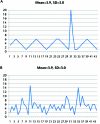Variability in postural control during infancy: implications for development, assessment, and intervention
- PMID: 20966208
- PMCID: PMC2996511
- DOI: 10.2522/ptj.2010033
Variability in postural control during infancy: implications for development, assessment, and intervention
Abstract
Variability is commonly considered a key to typical motor development. However, multiple definitions and quantification systems have limited the clinical interpretation of variability and the translation of developmental research to assessment and intervention. The purposes of this perspective article are to highlight the importance of statistical variability and complexity in postural control during development and to describe implications for assessment and intervention during infancy and early childhood. Five tenets are proposed describing the role of variability in postural control to support movement experiences, exploration, and global development. Evidence for assessment and intervention focused on variability in postural control are introduced.
Figures



References
-
- Thelen E, Smith LB. A Dynamic Systems Approach to the Development of Cognition and Action. Cambridge, MA: MIT Press; 1994
-
- Piek JP. The role of variability in early motor development. Infant Behav Dev. 2002;25:452–465
-
- Siegler R. Cognitive variability: a key to understanding cognitive development. Curr Dir Psychol Sci. 1994;3:1–5
-
- Adolph K, Berger S. Motor development. In: Kuhn D, Siegler R. eds. Handbook of Child Psychology, Vol 2: Cognition, Perception, and Language. 6th ed.New York, NY: Wiley; 2006:161–213
-
- Einspieler C, Precthl H, Bos AF, et al. Prechtl's Methods on the Qualitative Assessment of General Movements in Preterm, Term, and Young Infants. London, United Kingdom: Mac Keith Press; 2004

